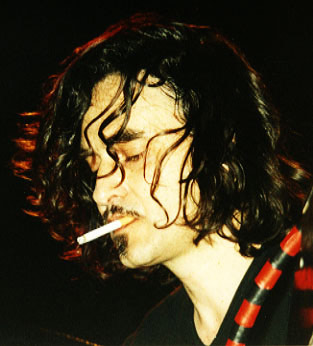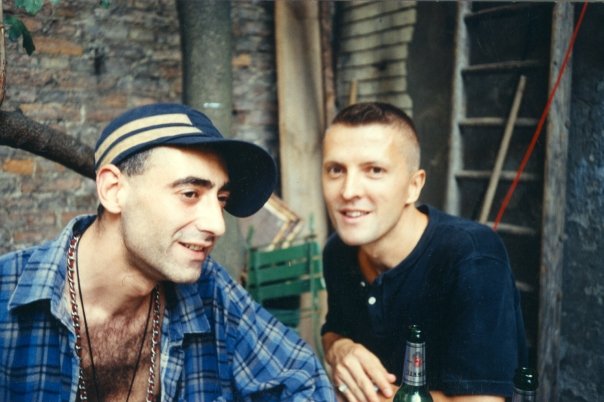|
Grauzone
Grauzone (German for "grey area", ) was a band from Berne, Switzerland, that was active and disbanded in the early 1980s. The band is most famous for their 1981 hit "Eisbär" ("Polar Bear"). The single charted at number 12 in Germany and number 6 in Austria. In addition to "Eisbär", they had some success with the singles "Film 2" and "Wütendes Glas". History Foundation At the end of 1979, Marco Repetto (drums) and GT (bass) left the punk band Glueams to form a new band called Grauzone with Martin Eicher (guitar, vocals, synthesizer). Martin had already supported Glueams on their single '"Mental". They gave their first concert in March 1980 at club Spex in Berne. Martin's brother Stephan Eicher (guitar, synthesizer), Max Kleiner and Claudine Chirac (saxophone) supplemented the group temporarily in live appearances and recordings. After ten concerts, four singles and an album the group split up at the end of 1982. After Grauzone GT and Marco Repetto formed a new band Mi ... [...More Info...] [...Related Items...] OR: [Wikipedia] [Google] [Baidu] |
Eisbär (song)
"Eisbär" (; ) is a 1980 cult hit composed by the Swiss Neue Deutsche Welle band Grauzone. It first appeared on the 1980 compilation album ''Swiss Wave - The Album''. The shorter single version was later collected on the Grauzone album ''Die Sunrise Tapes'' (1998). The song features a man singing he wants to be "a polar bear in the cold polar", because by being one he "wouldn't have to cry any longer and everything would be fine." The instrumental arrangement also evokes an Arctic atmosphere. Grauzone recorded in 1982 an English-language version (Polar Bear) of the song, which was first released in 2010 on the double CD ''Grauzone 1980-1982 Remastered''. The song is post-punk performed with guitar, drums and synthesizers. Track listing ; 7" single (1981) : A "Eisbär" (4:17) : B "Ich lieb sie" (I Love Her) (3:18) ; 12" single (1981) : A "Eisbär" (4:17) : B1 "Ich lieb sie" (3:18) : B2 "Film 2" (3:35) Chart performance Covers and cultural references * In 1990, Polar Pop (feat ... [...More Info...] [...Related Items...] OR: [Wikipedia] [Google] [Baidu] |
Stephan Eicher
Stephan Eicher (born 17 August 1960) is a Swiss singer. He sings in a variety of languages, including French, German, English, Italian, Swiss German and Romansh, sometimes using different languages in the same song. Eicher's success started in German-speaking countries in the 1980s when, as part of the band , he had a hit single, . With hit songs such as and , his popularity spread across Europe with albums, tours and chart success in France and Switzerland. Life Stephan Eicher was born in the rural municipality of Münchenbuchsee not far from Bern. Eicher was educated at the , an international boarding school in Switzerland, and musically trained at the academy of art in Zürich, where he learned how to use the computer for composing music. He released his first single , together with his brother Martin, on the album in 1980. He became interested in French songs by Jacques Dutronc, Georges Brassens and Serge Gainsbourg, and these influences led to the album . This alb ... [...More Info...] [...Related Items...] OR: [Wikipedia] [Google] [Baidu] |
Mittageisen (band)
mittageisen is a Swiss dark wave band of the early 1980s. The name refers to "Mittageisen", a single by Siouxsie and the Banshees that makes use of a John Heartfield photomontage on the cover. This picture was originally published on the frontpage of the "Arbeiter-Illustrierte-Zeitung / Workers Illustrated Journal", published on 19 December 1935. Heartfield (1891–1968) was an early member of the Club Dada, which started 1916 as Cabaret Voltaire in Zürich. The picture with the title 'Hurrah, die Butter ist Alle! / Hurray, the butter is finished!' shows a family who eats various pieces of metal. The trigger for it was the following sentence of a Göring-speech: "Iron made a nation always strong, butter and lard made only the people fat." History The group was initiated in 1981 by Bruno W (synthesizer, rhythm, voice/lyrics), after several Punk-activities (a.o. production of the first Swiss-Punk LP). The other initial members Daniel S (guitar) and Markus Sch (guitar, voice) p ... [...More Info...] [...Related Items...] OR: [Wikipedia] [Google] [Baidu] |
Switzerland
). Swiss law does not designate a ''capital'' as such, but the federal parliament and government are installed in Bern, while other federal institutions, such as the federal courts, are in other cities (Bellinzona, Lausanne, Luzern, Neuchâtel, St. Gallen a.o.). , coordinates = , largest_city = Zürich , official_languages = , englishmotto = "One for all, all for one" , religion_year = 2020 , religion_ref = , religion = , demonym = , german: Schweizer/Schweizerin, french: Suisse/Suissesse, it, svizzero/svizzera or , rm, Svizzer/Svizra , government_type = Federalism, Federal assembly-independent Directorial system, directorial republic with elements of a direct democracy , leader_title1 = Federal Council (Switzerland), Federal Council , leader_name1 = , leader_title2 = , leader_name2 = Walter Thurnherr , legislature = Fe ... [...More Info...] [...Related Items...] OR: [Wikipedia] [Google] [Baidu] |
Neue Deutsche Welle
Neue Deutsche Welle (NDW, , "New German Wave") is a genre of West German rock music originally derived from post-punk and new wave music with electronic influences. The term was first coined by Dutch radio DJ Frits Spits on the popular nationwide radio station Hilversum 3, which was very popular among German listeners. Soon after that, the term was used in a record-shop advertisement by Burkhardt Seiler in an August 1979 issue of the West German magazine ''Sounds''. It was then used by journalist Alfred Hilsberg in an article about the movement titled ("New German Wave — From Grey Cities' Walls") in ''Sounds'' in October 1979. History The history of the Neue Deutsche Welle consists of two major parts. From its beginnings to 1981, the genre was mostly an underground movement with roots in British punk and new wave music. It quickly developed into an original and distinct style, influenced in no small part by the different sound and rhythm of the German language, which ... [...More Info...] [...Related Items...] OR: [Wikipedia] [Google] [Baidu] |
Post-punk
Post-punk (originally called new musick) is a broad genre of punk music that emerged in the late 1970s as musicians departed from punk's traditional elements and raw simplicity, instead adopting a variety of avant-garde sensibilities and non-rock influences. Inspired by punk's energy and DIY ethic but determined to break from rock cliches, artists experimented with styles like funk, electronic music, jazz, and dance music; the production techniques of dub and disco; and ideas from art and politics, including critical theory, modernist art, cinema and literature. These communities produced independent record labels, visual art, multimedia performances and fanzines. The early post-punk vanguard was represented by groups including Siouxsie and the Banshees, Wire, Public Image Ltd, the Pop Group, Cabaret Voltaire, Magazine, Pere Ubu, Joy Division, Talking Heads, Devo, Gang of Four, the Slits, the Cure, and the Fall. The movement was closely related to the development of ... [...More Info...] [...Related Items...] OR: [Wikipedia] [Google] [Baidu] |
Berne
german: Berner(in)french: Bernois(e) it, bernese , neighboring_municipalities = Bremgarten bei Bern, Frauenkappelen, Ittigen, Kirchlindach, Köniz, Mühleberg, Muri bei Bern, Neuenegg, Ostermundigen, Wohlen bei Bern, Zollikofen , website = www.bern.ch Bern () or Berne; in other Swiss languages, gsw, Bärn ; frp, Bèrna ; it, Berna ; rm, Berna is the ''de facto'' capital of Switzerland, referred to as the "federal city" (in german: Bundesstadt, link=no, french: ville fédérale, link=no, it, città federale, link=no, and rm, citad federala, link=no). According to the Swiss constitution, the Swiss Confederation intentionally has no "capital", but Bern has governmental institutions such as the Federal Assembly and Federal Council. However, the Federal Supreme Court is in Lausanne, the Federal Criminal Court is in Bellinzona and the Federal Administrative Court and the Federal Patent Court are in St. Gallen, exemplifying the federal nature of the Confederation. ... [...More Info...] [...Related Items...] OR: [Wikipedia] [Google] [Baidu] |
Futurism
Futurism ( it, Futurismo, link=no) was an artistic and social movement that originated in Italy, and to a lesser extent in other countries, in the early 20th century. It emphasized dynamism, speed, technology, youth, violence, and objects such as the car, the airplane, and the industrial city. Its key figures included the Italians Filippo Tommaso Marinetti, Umberto Boccioni, Carlo Carrà, Fortunato Depero, Gino Severini, Giacomo Balla, and Luigi Russolo. Italian Futurism glorified modernity and according to its doctrine, aimed to liberate Italy from the weight of its past. Important Futurist works included Marinetti's 1909 ''Manifesto of Futurism'', Boccioni's 1913 sculpture ''Unique Forms of Continuity in Space'', Balla's 1913–1914 painting '' Abstract Speed + Sound'', and Russolo's ''The Art of Noises'' (1913). Although Futurism was largely an Italian phenomenon, parallel movements emerged in Russia, where some Russian Futurists would later go on to found groups of their o ... [...More Info...] [...Related Items...] OR: [Wikipedia] [Google] [Baidu] |
Techno
Techno is a genre of electronic dance music (EDM) which is generally produced for use in a continuous DJ set, with tempo often varying between 120 and 150 beats per minute (bpm). The central rhythm is typically in common time (4/4) and often characterized by a repetitive four on the floor beat. Artists may use electronic instruments such as drum machines, sequencers, and synthesizers, as well as digital audio workstations. Drum machines from the 1980s such as Roland's TR-808 and TR-909 are highly prized, and software emulations of such retro instruments are popular. Much of the instrumentation in techno emphasizes the role of rhythm over other musical parameters. Techno tracks mainly progress over manipulation of timbral characteristics of synthesizer presets and, unlike forms of EDM that tend to be produced with synthesizer keyboards, techno does not always strictly adhere to the harmonic practice of Western music and such structures are often ignored in favor of timbr ... [...More Info...] [...Related Items...] OR: [Wikipedia] [Google] [Baidu] |
Ambient Music
Ambient music is a genre of music that emphasizes tone and atmosphere over traditional musical structure or rhythm. It may lack net composition, beat, or structured melody.The Ambient Century by Mark Prendergast, Bloomsbury, London, 2003. It uses textural layers of sound that can reward both passive and active listening and encourage a sense of calm or contemplation. The genre is said to evoke an "atmospheric", "visual",Prendergast, M. ''The Ambient Century''. 2001. Bloomsbury, USA or "unobtrusive" quality. Nature soundscapes may be included, and the sounds of acoustic instruments such as the piano, strings and flute may be emulated through a synthesizer. The genre originated in the 1960s and 1970s, when new musical instruments were being introduced to a wider market, such as the synthesizer. It was presaged by Erik Satie's furniture music and styles such as musique concrète, minimal music, and German electronic music, but was prominently named and popularized by British mu ... [...More Info...] [...Related Items...] OR: [Wikipedia] [Google] [Baidu] |
Swiss New Wave Musical Groups
Swiss may refer to: * the adjectival form of Switzerland *Swiss people Places *Swiss, Missouri * Swiss, North Carolina *Swiss, West Virginia *Swiss, Wisconsin Other uses *Swiss-system tournament, in various games and sports *Swiss International Air Lines **Swiss Global Air Lines, a subsidiary *Swissair, former national air line of Switzerland *.swiss alternative TLD for Switzerland See also *Swiss made, label for Swiss products *Swiss cheese (other) *Switzerland (other) *Languages of Switzerland, none of which are called "Swiss" *International Typographic Style, also known as Swiss Style, in graphic design *Schweizer (other), meaning Swiss in German *Schweitzer, a family name meaning Swiss in German *Swisse Swisse is a vitamin, supplement, and skincare brand. Founded in Australia in 1969 and globally headquartered in Melbourne, and was sold to Health & Happiness, a Chinese company based in Hong Kong previously known as Biostime International, in ... [...More Info...] [...Related Items...] OR: [Wikipedia] [Google] [Baidu] |





